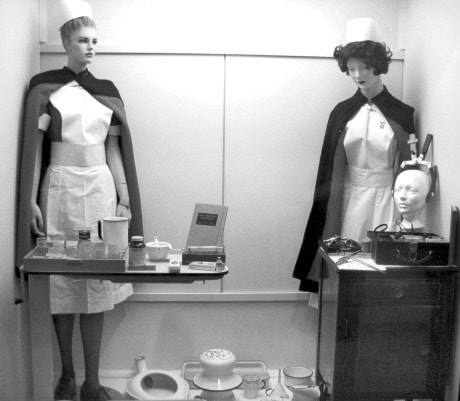The Fort Ostell Museum is located in the northwest corner of Lions’ Centennial Park, and the knowledgeable staff is always working diligently to put together many delightful displays and artifacts that salute the proud history, growth, successes, and progress of our community and districts over more than 100 exciting and memorable years.
The latest addition to the front lobby is a large and bright showcase that vividly depicts early treatment methods, surgical instruments and staff involvement at the Provincial Mental Hospital (now Centennial Centre), which will celebrate its 100th anniversary in July. Staff at the museum, including co-ordinator Sandy Allsopp, summer student Meagan Mitchell, manager Barb Greshner, board members and a host of dedicated volunteers, invite everyone to drop in and browse through this delightful collection of hospital and community memories.
When the massive provincial psychiatric hospital was opened to patients in July of 1911 there were very few trained staff or medications, and the care of the initial 164 men and women was strictly custodial, with 90 per cent of those admitted never completely recovering from their illnesses. With an ongoing increase of patient admissions, the need for professional administration, medical and support staff was sought throughout Canada and around the world. Along the way facilities were modernized and steadily expanded to accommodate in excess of 1,000 patients, with new methods of treatment, drugs, and therapy introduced to meet the growing demands of clients with mental illness from throughout Alberta and beyond.
In those early days, when Epsom salts was considered as a cure-all, the only means of controlling and calming patients with disturbed behaviour was a form of hydrotherapy, which consisted of two approaches. The first was where the patient was placed in a tub and held by a canvas cover, while warm water of 90 degrees was run through continuously. The second approach included the application of a sedative wet pack, which consisted of wrapping the patient in a wet sheet, covering them with blankets, and applying a hot water bottle to their feet. These carefully monitored treatments lasted about 90 minutes, during which vital signs were monitored and nourishment given, with the object being to sedate the patient without the use of drugs, and to assist them to sleep.
Other treatments included malaria therapy for luetics, which started in 1924, with the Ponoka hospital being one of the first in Canada to use the method and receive excellent results. Metrazol therapy was also used for a brief period in the Thirties, but was not considered satisfactory. This was eventually discontinued with the introduction of electrotherapy in the 1940s for the ongoing treatment of acute schizophrenia and manic depression, which was replaced briefly by chemotherapy treatments, but is still used to this day.
Lobotomies (psychosurgery) were introduced in 1935, and this surgical intervention of the brain would carry on until 1954 when the antipsychotic drug chlorpromazine was introduced. It is interesting to note that by 1937 all mechanical restraints were abolished at the Ponoka hospital, which was a milestone salute to the extreme progress and successes at the hospital. The advanced treatment methods and medication, and the dedication of the staff led the way, with an ever-present emphasis on healing and care.
With ongoing successes in treatment, recovering patients were also encouraged to take part in many forms of work and recreational therapy, as well as in daily social activities in and around the hospital. With the later availability of ‘tranquilizer’ drugs, other former methods of treatment were discontinued, while insulin therapy commenced in 1947 and continued with moderate success for some forms of psychosis until the 1960s.
The ongoing additions of new drugs and treatment methods, along with the excellent training, extreme care, and encouragement of highly professional staffs, have given hundreds of patients the opportunity to return to the basic skills of living and hopefully into an enjoyable life back in their community.
Early nurses’ uniforms also on display
Also on display along with the original Alberta Hospital collection in the front lobby of the Fort Ostell Museum are those early stiff, but very colourful nurses’ uniforms of the mid-century age at most hospitals. Early protocol for these young men and women followed the ‘medical model,’ which was always very apparent in the staff dress.
For women, the uniforms of starched cotton bibs and aprons were worn over cotton dresses with black or white nylons and their nursing pins. All of this bulky attire would indicate their present status in and about the hospital, from excited probies, through the hectic first and second years of training, then finally becoming proud graduates.
Student nurses were distinguished by their blue dresses, black stockings and shoes, while all would dawn those heavy black capes so that they could be recognized outdoors. The men wore a navy wool suit and later the Ben Casey white coat, while all that has changed nowadays into a flurry of bright and cheery colourful uniforms.
